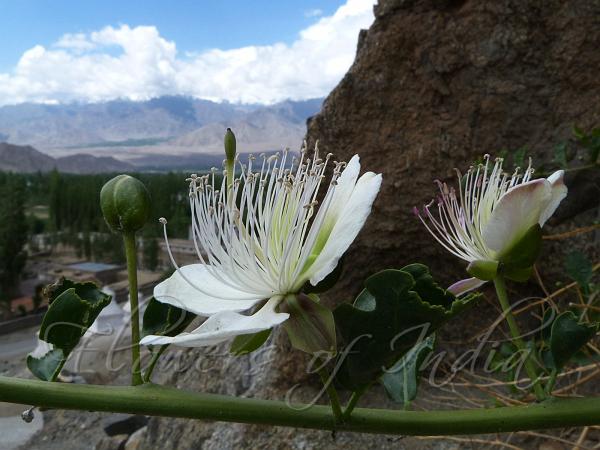|
| Alpine Caper Bush |
|

|

| File size | 286190 |
| Original date | 6/30/12 10:23 AM |
| Resolution | 1600 x 1200 |
| Flash | Flash did not fire, auto |
| Focal length | 4.5mm |
| Exposure time | 1/250s |
| Aperture | 5.6 |
| Focus Distance | |
| Metering Mode | Multi-segment |
| Camera make | Panasonic |
| Camera model | DMC-FZ40 |
| Sensor type | OneChipColorArea |
|
|
|
|
Photo: |
Botanical name: Capparis spinosa subsp. spinosa var. canescens Family: Capparaceae (Caper family)
Synonyms: Capparis obovata, Capparis napaulensis, Capparis leucophylla
Synonyms: Capparis obovata, Capparis napaulensis, Capparis leucophylla
Alpine Caper Bush is a spiny, trailing, deciduous
shrub. Twigs are velvet-hairy. Stipular thorns usually recurved, rarely
spreading or straight, up to 6 mm long. Leaf-stalks are grooved,
0.5-1.5 cm long. Leaf-blades are oblong, elliptic, elliptic-ovate or
elliptic-obovate, velvet-hairy to densely white-woolly especially when
young, later velvet-hairy to becoming hairless, 2-4.2 x 1.5-3.2 cm,
base usually nearly flat or rounded, tip blunt or tapering, rounded or
retuse, sometimes pointed, with a short sharp point or spiny with a
short sharp point, with mucro usually more than 0.5 mm and up to 0.9 mm
long. Flowers are zygomorphic; sepals 1.3-2.4 cm long. Petals are
1.8-2.8 cm long, broadly obovate or oblong. Stamens are numerous with
filaments pinkish or purplish in the upper part, up to 5 cm long, and
anthers violet, about 2 mm long. Fruits are ovoid or spheroid 1.8-4.2
cm long. Alpine Caper Bush is found on rocky slopes, foothills, cliffs,
steppic plains, dried river-beds, wastelands, roadsides, walls,
becoming a weed in cultivations; on clay, limestone and gypsum, often
in substrata rich in soluble salts. It is found from the Mediterranean
region eastwards to central Asia, India, Himalayas and Nepal, at
altitudes of 0-3600 m. Flowering: March-September.
| Identification credit: J.M. Garg | Photographed in Leh, Ladakh & Spiti, Himachal Pradesh. |
• Is this flower misidentified? If yes,